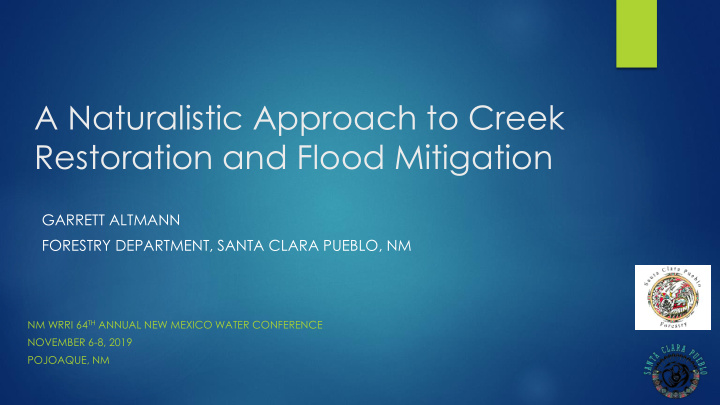



A Naturalistic Approach to Creek Restoration and Flood Mitigation GARRETT ALTMANN FORESTRY DEPARTMENT, SANTA CLARA PUEBLO, NM NM WRRI 64 TH ANNUAL NEW MEXICO WATER CONFERENCE NOVEMBER 6-8, 2019 POJOAQUE, NM
Overview : Santa Clara Pueblo Federally recognized Native American Tribe Located on the Rio Grande in Northern New Mexico Population: 2,700 Area: 90 square miles
Water is Life Santa Clara Creek Watershed 32,000 acre watershed North Central to the Pueblo lands and culture 26-mile stream Flows perennially from west to east Headwaters at 9,000’ Rio Grande Confluence 5,500’ Elevation gradient traverses several bioclimatic zones 1 mile
Upper Santa Clara Watershed in 2010 (looking south) 4 th Pond
Santa Clara Creek & 4 th Pond (2005) 4 th Pond
Fire History
Stand Replacing Crown Fire... Pre Fire Post Fire (2013) 4 th Pond 4 th Pond
After the fires came flooding…
Disaster Declarations Santa Clara Pueblo received five (5) Presidential Disaster Declarations: DR-4047-NM, August 19-24, 2011 DR-4079-NM, June 22-July 12, 2012 DR-4147-SCP, July 19-21, 2013 (tribal declaration) DR-4151-SCP, September 13-16, 2013 (tribal declaration) DR-4197-NM, July 27- August 5, 2014
Impacts & Changes Exponential increases in runoff/flood magnitude Destroyed infrastructure ($200M +) existing water control facilities- 4 recreational ponds roads, bridges, stream crossings, fire station, campgrounds Simulated 2 year (50%) to 10,000 year (.01% ACE) events 100% fish kill & habitat loss throughout entire Santa Clara Creek Reduced the water quality standards identified for high quality cold water fisheries Continues to impact natural and cultural resources… our grocery store, clothing store, pharmacy, and biologic classroom.
Four Ponds Debris Inundation 3 rd Pond 1 st Pond All four dams eventually failed and 4 th Pond 2 nd breached Pond
National Disaster Recovery Framework In 2011, FEMA released the National Disaster Recovery Framework (NDRF) to create a comprehensive Federally ‐ led strategy for the Pueblo to identify all possible actions that would build the community’s resiliency to future flooding. The NDRF provides states, tribes and local jurisdictions an opportunity to effectively develop recovery strategies within their respective areas. This support allows FEMA to extend resources to agencies and helps define: Roles and responsibilities of recovery coordinators and other stakeholders A coordinating structure that facilitates communication and collaboration among all stakeholders Guidance for pre- and post-disaster recovery planning Core recovery principles for communities to rebuild stronger, smarter and safer communities
Collaborative Partnerships
A Naturalistic Approach… A ‘stream first’ approach to flood mitigation Prioritizing natural function & promoting ecological services Infrastructure design to work with and enhance the stream system Bottomless culverts = Flood conveyance, sediment transport, fish passage Bank stabilization = erosion control & habitat complexity (bioengineering) Channel reconstruction = Natural channel restoration & floodplain connectivity Cost effective - Natural materials wherever possible (in-kind contribution) Develop resiliency: floods, droughts, fires Develop habitat for reintroduction of Rio Grande cutthroat & beaver
Santa Clara Watershed Restoration Implemented ‘top -down ’ approach to treating the watershed Restore sediment sourcing areas in tributaries while creek stabilized. Applied Hazardous Fuel Reduction, Reforestation and Bioengineering to: Mitigate future wildfire threat Provide a cost effective restoration approach Utilize abundant natural materials Facilitate reforestation Limit grazing effects Provide bank stabilization and promote habitat complexity Limit erosion and sediment transport
USFS Lands Nat’l Park Service Lands USFS Lands
Erosion Control Erosion control structures are constructed in tributaries to reduce sediment transport, minimize head cutting, and aggrade incised channels. The structures are cost-effective, being built by hand and using on- site materials. Over 5,300 structures have been built in 26 tributaries since 2014.
Recommend
More recommend